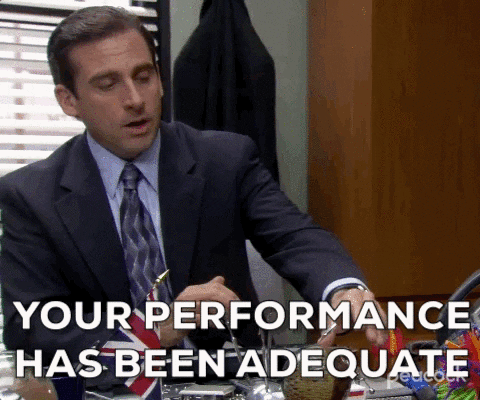Howdy! This week, the time-honored tradition of March Madness commences, and it’s HR’s perennial opportunity to unite college basketball aficionados and non-sportsball fans alike with some friendly competition. Print those brackets and engage those employees. Ready…break!
In today’s edition:
—Kristen Parisi
|
|
The Office/NBC via Giphy
Every other day, there seems to be a prediction of how ChatGPT will change peoples’ jobs forever. HR is no different.
While it may feel like science fiction, companies are already deploying some artificial intelligence to draft performance reviews. HR Brew spoke to one CEO about how he’s integrating ChatGPT to aggregate feedback.
The problems with perf reviews. The performance review process can be time-consuming and frequently takes HR departments months to compile and analyze. And the result can be limited, especially when only a manager is providing feedback or when employees are ranked on a subjective number scale. Performance reviews have become even more difficult as remote and hybrid work removed some potentially valuable (literal) employee visibility. Worse, traditional performance reviews are fertile ground for bias and unintentional negative consequences for some employees. HR departments are tasked with analyzing often inconsistent or unreliable employee feedback, and producing a coherent report that often impacts the employee’s job.
Enter ChatGPT, the language model trained by OpenAI. The emerging chat technology will certainly replace some tasks (especially the super-boring ones), but the AI chatbot won’t take over an HR manager’s job just yet.
One company, Confirm, launched a ChatGPT-powered performance review product last month. HR Brew spoke to Joshua Merrill, Confirm’s CEO, about how its system asks pointed questions to multiple direct-contact colleagues. He says the questions vary but they include, “Who do you go to for help and advice?” and “Who do you believe is an outstanding contributor?”
It then analyzes the data and uses ChatGPT to draft a performance review based on that feedback. “If all you were to do is answer those questions about your colleagues, we could actually predict what the manager would have rated them…about 80% of the time,” Merrill explained.
Keep reading.—KP
|
|
|
IT Brew sat down with Nick Szymanski, CIO and VP at Signature Healthcare, to talk about a tough workplace reality: burnout. During the pandemic, he jumped in to lead a team of 50 in setting up multiple COVID-19 testing sites—and he learned some valuable lessons. Read the full Q&A for tips on preventing burnout, especially on teams that work around the clock. Hint: Recognition is key.
|
|
Francis Scialabba
Asia has more of the world’s tallest skyscrapers than North America and according to some reports, they also have more workers filling them right now.
New research found that as employees in Asia and Europe are following calls (and the smell of breakroom snacks) back to the office, whereas cities in the US are lagging behind.
Where in the world? Pretty much everywhere except the US, apparently. In Asia, office return rates range from 80%–110% of their pre-pandemic levels, according to data from JLL shared by the Wall Street Journal.
The reason for the high return rates vary, but might be in part because city apartments, like those in Hong Kong, are not conducive to working from home, according to WSJ. Data also showed that countries like Singapore and China have shorter average commute times than large American cities.
Despite the mass return to the skyscraper, in Japan office workers still prefer the flexibility and autonomy of remote work. “Employees do now expect to be offered the option of working remotely,” Grant Torrens, managing director of Hays Japan told the Japan Times. “It has become a selling point for companies who are looking to not only retain their best talent, but also attract the same. It is now very common for candidates to list hybrid working as one of their ‘must haves’ when beginning a new job search.”
Satellite view. The US office occupancy rate has hovered around 50% since mid-February, according to data from Kastle Systems, a company that tracks security swipes. Cities in Texas have the highest return to office, with Austin (68.1%), Houston (61.8%), and Dallas (54.3%) topping out US cities.
Despite companies from Disney to Amazon mandating a return to the office, as well as layoffs, across the tech and entertainment industries, US-based workers aren’t going back for several reasons.
Keep reading.—KP
|
|
Alashi/Getty Images
Who doesn’t love a good glow up? Especially in the professional world. And in the HR universe, some rising stars are glowing in new (big) roles.
Disney. Sonia Coleman has been promoted to SVP and CHRO, according to Deadline. She’ll report directly to Disney’s new/old CEO, Bob Iger. She takes on the role on April 8, after around 15 years with Disney. The mouse house recently announced plans to lay off 7,000 employees and cut costs, so Coleman may have a Matterhorn-sized mountain of work ahead of her.
Peloton. Dalana Brand joined Peloton this month after serving as Twitter’s chief people and diversity officer, spending four years at the social network across different roles. Peloton has struggled financially since 2021, and Brand will be tasked with finding and retaining talent as the company changes its growth strategy, according to CNBC.
Nike. Elon Musk loses again as Twitter’s former VP of diversity, equity, inclusion, and accessibility, James Loduca, takes his seat as Nike’s new chief DE&I officer, according to Insider. “For more than 25 years, James has dedicated his career to addressing systemic inequality, uplifting underrepresented people and communities, and accelerating change,” Monique Matheson, CHRO at Nike, wrote in an internal email.
BBC. Finally, the BBC has tapped Uzair Qadeer as its new chief people officer. He’ll be in charge of helping the legacy news outlet accomplish its ten-point diversity plan, according to a press release. Qadeer joins the BBC after spending two years as chief people officer at Carbon Health.
Who’s glowing up next? We’ll keep you posted!—KP
|
|
Did you know you can leverage employee data to help your business make smarter decisions? Join us on 3/28 for a virtual event on making data work for HR. Led by Hilton SVP, HR Strategy & Talent, Christine Maginnis, we’ll discuss how to identify, organize, and leverage employee data for improved organizational outcomes.
Register today.
*This editorial content is supported by CareerBuilder.
|
|
Today’s top HR reads.
Stat: Non-executives spend a weekly average of 10.6 hours in meetings, according to a Future Forum survey, and 43% of them are unnecessary, workers say. (Financial Advisor)
Quote: “Culture matters. To reduce male preferences in high wage and leadership positions requires fundamentally changing organizational routines.”—Donald Tomaskovic-Devey, Center for Employment Equity at the University of Massachusetts Amherst, on gender discrimination in pay and workplace leadership (USA Today)
Read: Hit hard by the pandemic, the restaurant industry is still in need of more workers. (Investing)
Learn: Ever wanted to take a course made for the HR Brew professional? You’re in luck. Difficult Conversations at Work course will make you better at your job. Get your seat, it starts in less than 2 weeks!
Master’s in HR Management. A Master’s in Human Resources Management from Georgetown University teaches DE&I management, organizational development, and crisis management. Attend their webinar on Wednesday, April 5 at noon ET to learn more.*
*This is sponsored advertising content.
|
|
-
Meta recruitment teams will be among the first cut by the social media company, which announced another 10,000 layoffs Tuesday.
-
Southwest Airlines announced more winter staffing following last December’s mass cancellations that left tens of thousands of travelers (and Southwest employees) stranded.
-
Uber, Lyft, and others scored a major victory when a California court upheld a measure classifying gig workers as contractors rather than employees.
-
Women’s labor force participation is on the rise after a sharp decline at the onset of the pandemic.
|
|
Catch up on the top HR Brew stories from the recent past:
|
|
|







